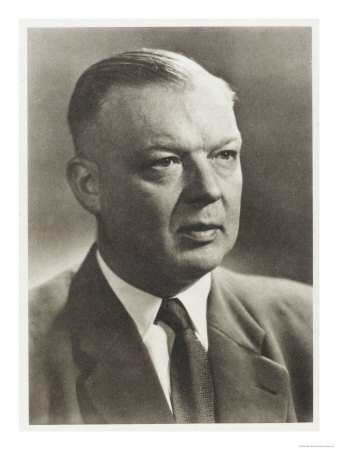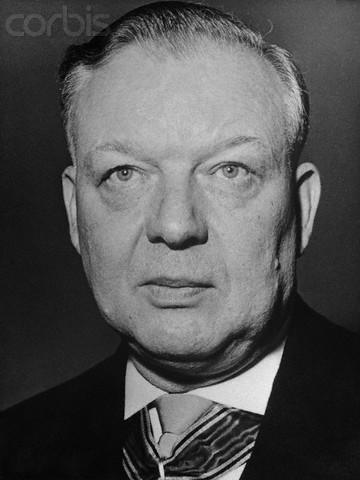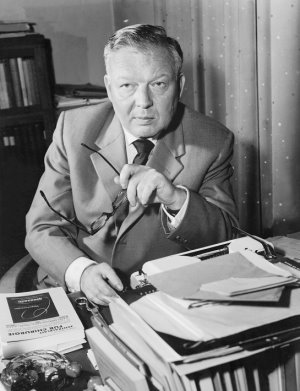<Back to Index>
- Physician Werner Theodor Otto Forßmann, 1904
- Latinist and Poet Janus Pannonius, 1434
- President of the Provisional Government of the Republic of Korea Kim Gu, 1876
PAGE SPONSOR



Werner Theodor Otto Forßmann, (August 29, 1904 – June 1, 1979) was a physician from Germany who shared the 1956 Nobel Prize in Medicine (with Andre Cournand and Dickinson Richards) for developing a procedure that allowed for cardiac catheterization. In 1929, he put himself under local anesthetic and inserted a catheter into his own arm. Not knowing when the catheter might pierce a vein, he risked his own life and was able to pass the catheter into his own heart.
Forßmann was born in Berlin on August 29, 1904. Upon graduating from Askanische Gymnasium, he entered the University of Berlin to study medicine, passing the State Examination in 1929.
He hypothesized that a catheter could be inserted directly into the heart, for such applications as directly delivering drugs, injecting radiopaque dyes, or measuring blood pressure. The fear at the time was that such an intrusion into the heart would be fatal. In order to prove his point, he decided to try the experiment on himself.
In 1929, while working in Eberswalde, he performed the first human cardiac catheterisation. He ignored his department chief and when a nurse tried to stop him, he tied her to an operating table. Then, he anesthetized his own lower arm and inserted a cannula into his antecubital vein, threading it 65 cm all the way to his heart. Afterwards, he walked some distance to the X-ray department to photograph the catheter which was now lying in his right atrium.
The head clinician at Eberswalde, recognizing Werner's discovery, created an unpaid position for him at the Berliner Charité Hospital, working under Ferdinand Sauerbruch. Though, once Sauerbruch saw his paper, he was thrown out of the hospital. Sauerbruch commented, "You certainly can't begin surgery in that manner". Facing such disciplinary action for self-experimentation, he was forced to quit cardiology and take up urology.
He left to work at City Hospital at Mainz. And then, went to study urology under Karl Heusch at the Rudolf Virchow Hospital in Berlin. Later, he was appointed Chief of the Surgical Clinic at both the City Hospital at Dresden - Friedrichstadt and the Robert Koch Hospital in Berlin.
In 1933, he married Dr. Elsbet Engel, a specialist in urology.
From 1932 to 1945, he was a member of the Nazi Party. At the start of World War II, he became a medical officer. In the course of his service, he rose to the rank of Major, until he was captured and put into a POW camp. Upon his release in 1945 he worked as a lumberjack and then as a country doctor in the Schwarzwald with his wife. In 1950, he began practicing as urologist in Bad Kreuznach.
During the time of his imprisonment, his paper was read by André Frédéric Cournand and Dickinson W. Richards. They developed ways of applying his technique to heart disease diagnosis and research. In 1956, the Nobel Prize in Physiology or Medicine was awarded to Cournand, Richards, and Forßmann.
After winning the Nobel Prize, he was given the position of Honorary Professor of Surgery and Urology at the University of Mainz.
Later, in 1954, he was given the Leibniz Medal of the German Academy of Sciences. And, in 1961, he became an Honorary Professor at the National University of Córdoba. In 1962, he became a member of the Executive Board of the German Surgical Society. He also became a member of the American College of Chest Physicians, honorary member of the Swedish Society of Cardiology, the German Society of Urology, and the German Child Welfare Association.
He and Elsbet had six children: Klaus Forßmann in 1934, Knut Forßmann in 1936, Jörg Forßmann in 1938, Wolf Forßmann in 1939 (who was first to isolate the atrial natriuretic peptide), Bernd Forßmann in 1940 (who helped develop the first clinical lithotriptor), and Renate Forßmann in 1943.
He died in Schopfheim, Germany of heart failure on June 1, 1979.